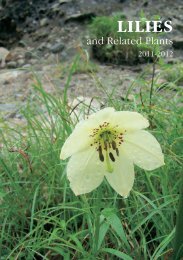LILIES - RHS Lily Group
LILIES - RHS Lily Group
LILIES - RHS Lily Group
Create successful ePaper yourself
Turn your PDF publications into a flip-book with our unique Google optimized e-Paper software.
Sibthorp knew it only from cultivation. Hawkins made several other remarkable<br />
discoveries. For instance, he was the first to observe the horse chestnut, Aesculus<br />
hippocastanum, growing wild in the same general area. At that time it was already<br />
known in cultivation in central Europe, having presumably been introduced via<br />
Istanbul, but its native distribution is restricted to a rather small area in Greece<br />
and southern Albania. Lilium chalcedonicum was reported from “montis Parnassi<br />
sylvosis, et in insulâ Zacyntho” (the latter certainly in error), whereas L. martagon<br />
was said to grow “in montosis umbrosis Graeciae” without further specification.<br />
In Conspectus Florae Graecae (1904) – still the latest comprehensive Flora<br />
of Greece – Eugen von Halácsy listed Lilium chalcedonicum and L. martagon<br />
from several localities in the mountains of Sterea Ellas and Thessaly, and a new<br />
species, L. heldreichii, was added. The latter had been described by Freyn in 1880<br />
from Mt Parnitha (Parnes) in Attica and was said to differ from L. chalcedonicum<br />
in the broader leaves and 1-flowered stem. As we shall see, however, the latter<br />
shows considerable variation according to the habitat and it is almost certain the<br />
L. heldreichii is nothing but a depauperate form of L. chalcedonicum. The white<br />
madonna lily, Lilium candidum, was reported “in rupestribus regionis montanae”<br />
as well as “frequenter colitur quoque in hortis”, indicating that it grows wild<br />
in the mountains and is also frequently cultivated. Finally, an interesting new<br />
species was added: Lilium albanicum, collected on Mount Smolikas in Epirus by<br />
the Italian botanist Antonio Baldacci. This species had been described already by<br />
August Grisebach in 1846, based on his own collection in 1839 from Scardus or<br />
Šar Planina, a large mountain range on the present border between Macedonia<br />
and Kosovo. It is a relatively small, early-flowering species with deep yellow<br />
flowers, growing in meadows at high altitude on non-calcareous substrate.<br />
A distinct new species, Lilium rhodopeum, was described as late as 1952 by<br />
the Bulgarian botanist Dimiter Delipavlov. It was reported from the Bulgarian<br />
side of the Rodhopi mountains and has subsequently been found also south of<br />
the border, growing in damp meadows at an altitude of 1300-1800m. It has a very<br />
restricted distribution and in rarely seen in cultivation.<br />
The five Greek species can be keyed out as follows:<br />
1. Lower and middle leaves in whorls of 5-10.<br />
Buds more of less lanate to villous . . . . . . . . . . . . . . . 3. L. martagon<br />
– All leaves alternate. Buds glabrous or puberulent . . . . . . . . . . . . 2.<br />
2. Flowers yellow . . . . . . . . . . . . . . . . . . . . . . . . . . . . . . . . . . . . . . . 3.<br />
– Flowers white or scarlet. . . . . . . . . . . . . . . . . . . . . . . . . . . . . . . . 4.<br />
key continued overleaf<br />
19




